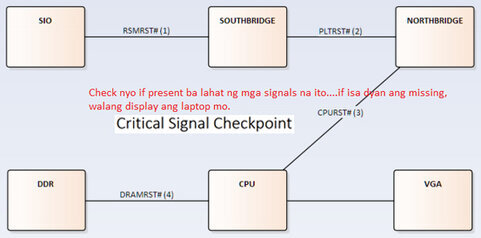j4m2_6
Registered
- Joined
- Apr 27, 2021
- Messages
- 1,435
- Reaction score
- 2,959
- Points
- 341
- Location
- La Union ™️ ( Region 1 )
Troubleshooting Guide No Display Issue
###
-->
• Perform level 1 problem isolation
• Perform visual inspection and check for corrosion and burnt components.
• Perform basic tests
• External keyboard if responding or not
• External monitor if display comes out
• Remove attached Bluetooth/wifi module
• Replace w/ known good memory
• Replace w/ known CPU
• Clean the board via sonic machine if needed
• Make sure the following is normal
• Current-sense resistance and voltage is normal- 1Mohm or higher
• Current consumption is normal in S5 state – (pagsaksak sa dc bench power supply dapat 0.01A or less)
• Use the current jump method to verify that the board powers up properly.
• A good/working laptop would roughly have current consumption jumps approximately 4-6 times before initializing the OS
• The number of jumps depend on several factors:
• Type of CPU
• with or without GPU
• Flash with stock System BIOS to make sure the problem is not firmware-related
• Using critical signal checkpoint and power sequence summary, measure
• PLTRST# at pin 22 wifi slot - 3.3v
• DRAMRST# at pin 30 DDR slot –1.35v/1.5v/1.8v
• Activity in data lines in display ports (vga, lvds and hdmi) using oscilloscope
-->
Nominal Resistance Readings
Voltage Rail Nominal Resistance
GPU regulator coil/capacitor >3-7 ohms
CPU regulator coil/capacitor kΩ (CPU not attached)
> 3-7Ω (CPU attached, baytrail, haswell, etc.)
USB regulator capacitor kΩ
Memory regulator coil/capacitor Ω (newer processor)
kΩ (old cpu)
3v/5v Main regulator coil/capacitor kΩ (for older laptop, may go down as low as 200 Ω)
Battery Charger coil/capacitor (near battery connector) kΩ
Note: All voltage and resistance readings are made with negative (black) probe connected to ground.
Resistance readings may be lower/higher than listed but may still be normal.
Always check schematic diagram if available...
